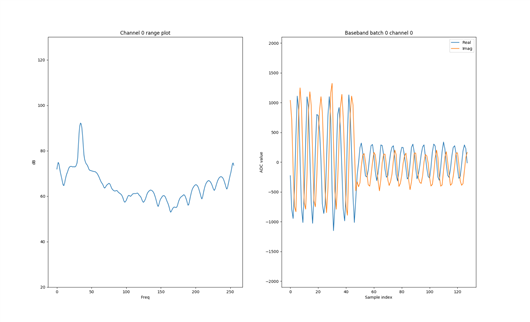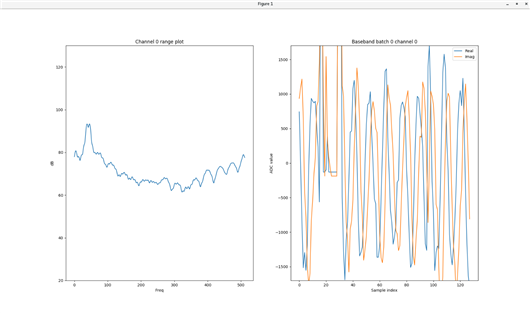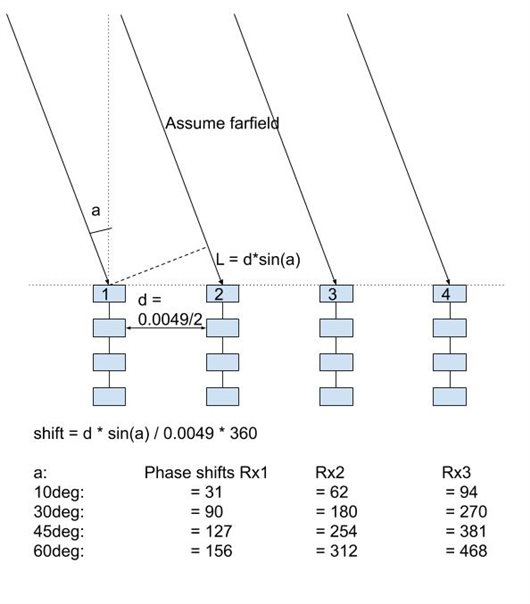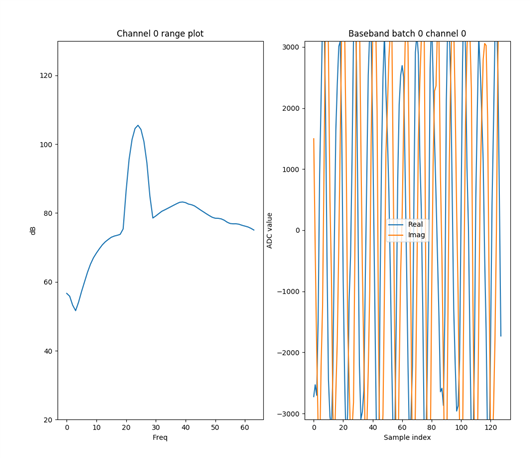Hi
I am still trying to extract the phases of the individual Rx antennas.
To do so, I have two antennas, running CW:s at a certain offset facing each other.
I have a dca1000 connected to one IWR6843 reading out the ADC raw data from it while in CW mode (we have this working)
but when looking at the baseband the data looks to odd.
It look like sometimes the data is a mix of two different chirp data, see image. I am expecting one good looking sinus wave.
I have tried enabling the HSI header to mark the beginning of every frame but this does not seem to help.
Can you point me in any direction of how to find out why the data looks broken?
Here is some code creating the plots (Python)
r_win = np.blackman(conf['n_samp'])
for frame_index, data in data_loader.read_frames():
cube = data['cube']
cube -= np.mean(cube, axis=0, keepdims=True) # remove DC
r_cube = np.fft.fft(cube * r_win.reshape(-1, 1, 1), axis=0, n=conf['ran_n_fft'])
# incoherent integration in doppler to improve SNR
dop_result = np.mean(np.abs(r_cube), axis=1)
plt.clf()
plt.subplot(121)
plt.plot(20 * np.log10(np.abs(dop_result[:, 0])))
plt.title('Channel 0 range plot')
plt.ylabel('dB')
plt.xlabel('Freq')
plt.ylim(20, 130)
plt.subplot(122)
plt.plot(np.real(cube[:, 0, 0]), label='Real')
plt.plot(np.imag(cube[:, 0, 0]), label='Imag')
plt.title('Baseband batch 0 channel 0')
plt.ylabel('ADC value')
plt.xlabel('Sample index')
plt.legend()
plt.ylim(-2100, 2100)
plt.pause(0.01)
------------------------------------------------------------------------------------
This is my current configuration for the IWR6843 with the DCA1000 board.
sensorStop
flushCfg
dfeDataOutputMode 2
channelCfg 15 2 0
adcCfg 2 1
adcbufCfg -1 0 1 1 1
lowPower 0 0
contModeCfg 61.245350 0 0 2000 0 0 30 1 128
% contModeCfg 61.246 0 0 3125 0 0 30 1 128
% contModeCfg 61.25040625 0 0 3125 0 0 30 1 128
guiMonitor -1 1 1 1 0 0 1
cfarCfg -1 0 2 8 4 3 0 100 0
cfarCfg -1 1 0 4 2 3 1 100 0
multiObjBeamForming -1 1 0.5
calibDcRangeSig -1 0 -5 8 256
clutterRemoval -1 0
compRangeBiasAndRxChanPhase 0.0 1 0 1 0 1 0 1 0 1 0 1 0 1 0 1 0 1 0 1 0 1 0 1 0
measureRangeBiasAndRxChanPhase 0 1. 0.2
aoaFovCfg -1 -90 90 -90 90
cfarFovCfg -1 0 0 45
cfarFovCfg -1 1 -10 10
extendedMaxVelocity -1 0
CQRxSatMonitor 0 3 4 63 0
CQSigImgMonitor 0 127 4
analogMonitor 0 0
lvdsStreamCfg -1 1 1 0
bpmCfg -1 0 0 0
sensorStart






